Update Feb 6: We got a check for $10,568.41 today from CareFirst, which is actually about $100 more than I expected. So we have now been reimbursed for 55% of the expenses discussed below. Our next step is to appeal for a “network waiver” to have the devices covered as an in-network expense rather than out-of-network, which would cover a good deal of the rest.
Update March 6: I’ve posted a long “first look” review of the processors here.
*
As my Facebook friends know, I recently ordered two new “Naida” cochlear implant processors.
What’s a cochlear implant processor, you ask? It’s the thing that sits on my ear and looks like a hearing aid. (Pix below.) It collects sound, digitizes it, and sends the bitstream by radio to the cochlear implant embedded in my skull. (It’s all explained in my first book, Rebuilt.)
I’ve had my old “Harmony” processors for something like seven years. They’re falling apart. The plastic paint on them has mostly worn off. The battery connectors are so worn that the batteries can, and do, slide right out and fall to the floor. And the batteries themselves are fading, yielding only 4 or 5 hours of life instead of the 12 to 15 when new. It’s time.
So when I learned a few months ago that Advanced Bionics had released a new processor, I was very interested. Called the “Naida,” it’s the love-child of a marriage between Advanced Bionics, which makes my cochlear implants, and Phonak, which makes high-end hearing aids.
So the Naida is a cochlear implant processor that includes the features of high-end hearing aids. For example, it has multiple microphones, which let the device amplify what’s in front of you while suppressing sounds behind you. That comes in very handy in restaurants.
Thing is, a pair of two, plus accessories, costs $19,210. Yes, almost twenty thousand dollars.
Since it’s a medical device, I figured that my insurer, CareFirst, would buy them, asking me to pay whatever percentage wasn’t covered. Wrong. I had to buy them upfront, and then file a claim and wait to be reimbursed. And I wouldn’t know how much I would get back until they processed the claim.
After some thought I decided to use an airline credit card to get the miles (which would net me a free roundtrip flight.) I called Advanced Bionics and placed the order on December 6, 2013. Yikes. I hoped CareFirst would reimburse me soon enough to pay it off quickly.
The box arrived on December 9th. I put it in our TV room. It was a very big box for two little things that sat on my ears. What the heck was inside it?
Advanced Bionics assured me that if insurance refused to pay, I could send it back for a refund. But the box had to be unopened. So I didn’t open it. The cats treated it like furniture, sleeping on it while we watched “The Sopranos.” The rest of December went by. I checked CareFirst’s website daily. All of January went by. D.C. froze in the meantime, with nighttime temperatures of two degrees Fahrenheit.
On January 29th, 2014, CareFirst told me they were cutting a check for $10,468.92. Actually, my mom told me. My mom has connections. Two days later, I got confirmation from CareFirst’s website.
$10,468.92 is a nice chunk of change, but it’s well short of $19,210. It’s about 55% of it. I called CareFirst to ask why. Turns out they regard Advanced Bionics as an “out-of-network” provider. And they reimburse out-of-network purchases at a lower rate.
I turned to Facebook. My FB thread on The Box had grown to over 100 comments in seven weeks. My FB friends told me I could file an appeal to CareFirst to have Advanced Bionics treated as an in-network provider, which would mean they’d pay more than 55%. After all, there’s no one else I can get the Naidas from. I can’t buy them from my in-network ENT.
Good enough. Last night, I opened The Box.
- After seven weeks, I prepare to open The Box.
(It is very cool, by the way, to open a box labeled “Advanced Bionics.” It sounds very 21st-century.)
And here was what was in it:
Wow. I hauled them out, one after the other.
Not knowing where to start, I began opening zippers.
And then I started opening the boxes. Inside them were lots and lots of little boxes. Boxes containing cables and batteries and microphones and headpieces and headpiece covers and chargers and plugs and power adapters and dri-aid bricks. And a ComPilot and a myPilot, whatever exactly those are. Every single piece was lovingly sealed in a little box of its own.
So this is what $19,210.00 of cochlear implant hardware looks like:
To explain it all there’s a bunch of fat manuals. They’re not quite as fat as they look, actually, because each one is the same manual in six languages.
Finally, I found the processors themselves. I had to open various boxes to piece one together. Here it is:
This is the heart of the box. This is the payload. Everything else is just fuel, so to speak.
I tried putting it on and having my wife take a picture of it.
The first thing you notice — or that I notice, at any rate — is that my hair is getting a little thin.
It fits nicely, doesn’t it? But it doesn’t do anything yet. That red light means it has no software on it. I have to take it to the audiologist to have my Harmony software upgraded and loaded onto it. That’ll happen on February 27th 20th.
Compare it to a Harmony, the older device, on the other side:
The Naida is definitely smaller and thinner than the Harmony. Very nice.
And it has lots of cool features. For example, both Naidas will contain the programs for both implants, so I can use either on either side. No more of my wandering around the apartment muttering, “Now where did I put my right ear?” I can just pick up the first processor I find and slap it on.
And when I use the phone, the sound from it will be heard in both my ears. Apparently one will shuffle the signal on to the other, transmitting it by radio straight through my head.
And there’s a whole thing about Bluetooth connectivity that I simply will not understand until I fire up the myPilot and/or comPilot and try them out. Direct input from TVs and iPhones and whatever.
More fundamentally, the Naidas are supposed to have better “front-end software” that processes sound more smoothly and accurately. Whether this will make a difference for me is entirely unknown.
So there’s that other 45% that we still have to pay. But my FB friends seem to feel sure the appeal to CareFirst will work, which will further reduce our cost.
And apparently Advanced Bionics will buy back my old Harmony processors for $1,900 apiece. Why they would pay that much for worn-out old processors I don’t know, but I’m not arguing. So even if CareFirst refuses to cough up any more, our final price won’t be higher than about $5,000, which we can live with.
It’s very nice to have a new piece of hardware with manuals telling you all the cool stuff it will do. No geek can resist a hardware upgrade. I’ll keep you all posted when I have it programmed on February 27th 20th.
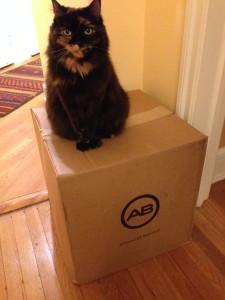

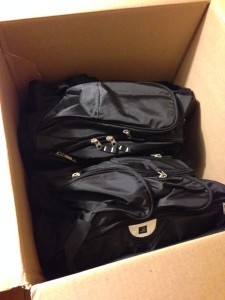
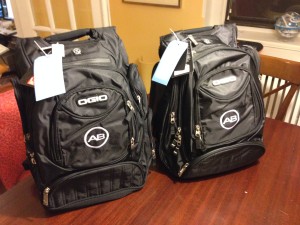
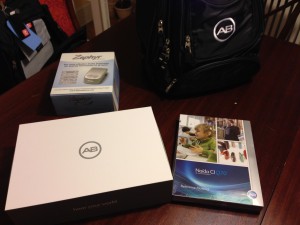
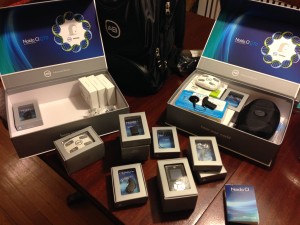
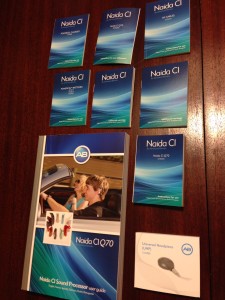
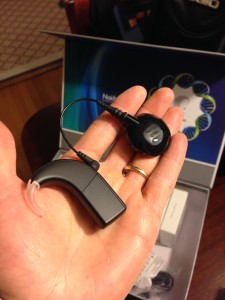
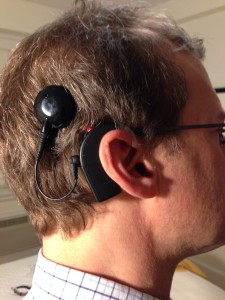
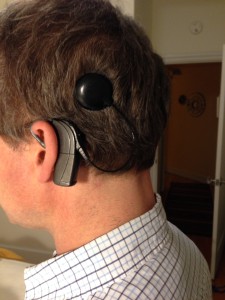

Hi Michael
Very interested in the new equipment. Amazing they just shunt two of everything in the box like that. But I suppose it’s just easier.
Pusscats must have been dying with anticipation!
The health insurance in the States sounds like a bureaucratic nightmare! We can’t tell you what the rebate will be… how ridiculous!
I can’t understand the resistance to national health, or our Australian governments push to dismantle something that works well, for the good of the whole country. Typical idiotic conservatives.
Anyway enjoy the new equipments – just try and keep the cars out of the box (good luck!)
Happy hearing
JC
Hi Michael, I am having the AB implant March 19th. I will also be getting the Naida, but only in the right ear, my left will contain the Phonak Naida hearing aid. I am Lucky, I guess, my hearing loss comes from US Military connection, basically lost my hearing serving and protecting our country, so now the VA is funding the implant, since they are the ones ordering the processors, etc, not sure if I will be getting all the goodies that you got but, I guess all I really want is to be able to hear again. I am curious on what you think of the equipment. I am excited and petrified at the same time. I was told to chose between Cochlear Nucleus N6, AB Naida or the MedEL Rondo, which was like telling me to pick the best bra that I have to live with for the rest of my life. I just want to know I chose something that is going to allow me to hear. It doesn’t have to be the best, it just has to work for me. Like your pair, I was told that the Naida implant can communicate with my Naida hearing aid, which is a big plus Please keep me posted with your results as I am new to the cochlear world. Thank you for sharing.
Michael, thanks for the note. That’s a great idea, to have Phonak devices on both sides – that means that any gadget that works for one side will also work for the other. That makes your decision to get the Naida the clear best choice. But I can certainly understand being “excited but petrified.” It’s a big step for anyone. If it’s any comfort, I personally found the surgery to be very easy. I felt groggy and a little sore for two days, and was up and around the third day and basically back to normal. (By the way, If you were born in 1963, that makes us almost the same age, as I was born in 1964.) Congratulations and good luck to you, sir.
Dear Mr Chorost…. Thank you for the valuable information you share with us. I am new in the field and I have a dumb question.
It puzzles me that you bought two cochlear implant processors directly from AB and almost ready to use them except for your visit to the audiologist.
So I realize that there are 2 separate items in a cochlear implant: the processor like the one you bought and the cochlear implant itself embedded in your skull. Am I correct ??
So it is possible to buy the kit from Advance Bionics and handle it to the surgeon to perform the surgery and handle the processors to the audiologist ? Do you thing it is possible ??
I am asking this question because I don’t have the resources to pay the surgery itself and the 2 cochlear implant kits.
I am being asked US$35,000 for each kit, and it puzzles me that you just paid $US 20,000.00 for the two processors. Something doesn’t fit.
Do you think AB might want to sell the items separately.??
Are you aware if some one might help me with the financial resources ??
I am writing from Latin America. Regards CB
So I realize that there are 2 separate items in a cochlear implant: the processor like the one you bought and the cochlear implant itself embedded in your skull. Am I correct ??
—> Yes, that’s correct! I’m only referring to the externally worn processors.
So it is possible to buy the kit from Advance Bionics and handle it to the surgeon to perform the surgery and handle the processors to the audiologist ? Do you thing it is possible ??
—> What happens is, AB sends the entire thing to your surgeon and audiologist. At your first mapping, you get the external processor and all its accessories from the audiologist.
I am being asked US$35,000 for each kit, and it puzzles me that you just paid $US 20,000.00 for the two processors. Something doesn’t fit.
—> Every country has its own ways of doing things. In the United States the whole thing is usually covered by insurance, especially when you’re getting the implant installed. Subsequent new processors may be things you have to pay for (as was true for my Naidas, though insurance paid a large percentage for it.)
Are you aware if some one might help me with the financial resources
—> I would talk to someone from Advanced Bionics. They have contact information on their website. They want you to get their product, so they’re motivated to help you. Good luck!
Mike